
Amal Graafstra Gets an RFID Implant
“The future is here.
It’s just not widely distributed yet.”
- William Gibson
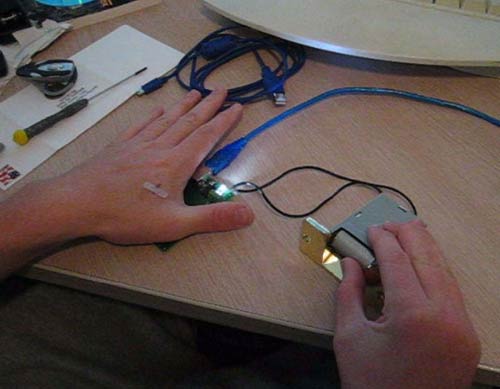
Of all the fears associated with the technological advancements
of the computer age — and
there
are
many — the most long-standing
and pervasive is, arguably, humans being tagged and monitored in some fashion,
often either by bar codes
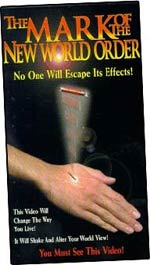
Does Biblical Scripture
warn us of the coming
of Amal Graafstra?
|
or microchips. And it’s not an entirely unfounded fear; outfitting
pet animals with chips has become standard procedure for identity purposes,
and has generally met with great success. Small, low-frequency RFID
(Radio Frequency IDentification) tags are encoded with
information about the subject and are subsequently embedded in them, rendering
their details available to anybody within arm’s reach — who happens to have
an RFID reader. Even with basic knowledge about the technology, it’s quite
easy to imagine the potentially frightening implementations of it. Needless
to say, convincing humans that an RFID implant is right for them can be
a hard sell; even ostensibly useful applications of the technology, such
as Spanish
clubs offering their VIP customers the option of receiving an implant
that acts as a debit card — so as to avoid carrying a wallet or purse —
can be revealed for their sinister
capabilities.
That’s the wonderful thing about technology though — as scary and awful
as some may find specific uses of
certain things, there are always those
who can see the other side of the coin. In this case it’s Amal Graafstra,
a Washington state native and business
owner who recently underwent the minor procedure of getting an RFID
implant in his left hand, and has lightly documented the process on his
personal web site. A lifelong tinkerer, Amal describes himself as the
kind of guy who, if he lost an arm in a horrible accident, would be “totally
bummed about losing my beloved arm, but also kind of excited about what
kind of bionic apparatus I might get to tinker with as an experiment.” Eventually,
he’d like to outfit everything from his car to his home with sensors; BME
recently spoke to Amal about his venture into the world of implant technology.

BME: |
What’s your background with RFID technology?
|

AG: |
I have no RFID background at this point, though I do have an extensive tinkering and gadgetry background. I like to mod things, and I guess it was only natural that it extended to my own body.
I became interested in RFID and other alternate means of identification a while back. I constantly lose my keys and my wallet — yeah, I’m one of those guys. So I was sitting around thinking about keys and credit cards, and the obvious truth that these chunks of metal and pieces of plastic were really representing me and basically identifying me to whatever mechanisms and systems they worked with, be it my front door deadbolt or my bank account. I basically just wanted to get rid of my keys and wallet.
|

BME: |
Why choose RFID over other similar technologies?
|

AG: |
Well, a lot of people ask why not use BioMetrics, the approach that uses your own body and features to identify you... and I guess I have my own Big Brother paranoia. Given the choice of Orwellian societies, I’d rather live in one based on RFID tags than fingerprints, DNA, or facial structure; an RFID tag system is easy to manage and opt out of, whereas DNA sampling or facial recognition, well, isn’t.
As for the future of my involvement with RFID past my own projects, I’m already talking to many of my clients — I provide services to medical clinics and other medical related industries — for tracking products and items, such as blood test vials, throughout the entire process: From collection to testing to storage, and eventually to disposal or whatever it’s final destination is.
|
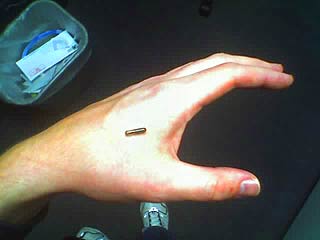
Pre-Implant |
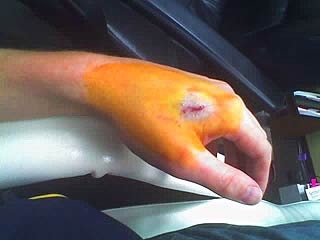
Post-Implant |

BME: |
What are the specifications of your implant? Are there more powerful options available?
|

AG: |
The one I have in my hand is l2mm long by 2mm in diameter and has a basic read
range of two inches. However, that includes through flesh, so from
the back of my hand it’s about an inch to an inch and a half. From
the palm side though, I basically have to place my palm on the sensor
to get a read. With a better reader I might be able to get three inches,
but I think the chip tops out at that point. There is a more powerful
implant option available, but it’s huge: 34mm long and 4mm in diameter,
and the read range is only about double — under ideal conditions,
you’re probably only talking about 4 to 6 inches tops.
Another thing to consider is that this implant uses low frequency,
operating off a 125KHz signal. There are all kinds of RFID chips out
there for all kinds of purposes. The high frequency chips could probably
be made for implanting and have a much longer read range. Under most
circumstances, however, the short read range is more of a benefit
than it is a hindrance.
|

BME: |
You mean for security purposes? That seems like it would
be a concern, considering your desired uses for the technology (home and automobile
entry, wallet replacement, and so on).
|

AG: |
Yeah. Though there is already encryption in use
with RFID tags; gas pumps that use those keyfob speedpasses are based
on encrypted RFID. There are RFID chips in car keys already that are
encrypted and use a challenge/response system to ensure you can’t fake
it, but these systems have already
been cracked. As far as I know, there aren’t any implant-grade chips
that even offer this encryption yet.
For me personally though, with the read range being only an inch, stealing my RFID tag ID would be a rather personal encounter. Getting that tag ID duplicated would be another difficult task for your average carjacker — it would honestly be easier to just smash my window. I could also employ a two-phase system that would require my chip ID and, say, a voice recognition pattern match, a fingerprint match, or some other quick method of identification if it came down to it — maybe even detecting my Bluetooth enabled cell phone would be enough. Bottom line though, any security system you employ can be hacked, thwarted, or otherwise subverted — even deadbolt locks. It takes me about ten minutes to pick a good deadbolt lock with a $30 lock pick set; I once let a friend into his house by picking his deadbolt and his doorknob lock in less than five minutes. It really shook him up that it was so easy to get in, but I pointed out that anyone can break a window or “credit card” the door-jam just as easily. 99% of the day, we feel safe because of the illusion of security, not the actual existence of it. Take driving for example... you rely on others to stay on their side of the line; your life is in the hands of every driver around you.
|
Amal Makes It Out Alive

BME: |
Now, who actually performed the implant procedure?
|

AG: |
As I have not asked the doctor for permission to publish their name, I can’t give that out, but they happen to be a cosmetic surgeon, so it seemed the natural choice. However, it was not hard to find someone to do the procedure; I have many MDs for clients and the day I got my chips, I asked two and both said they’d do it. I also stopped into a tattoo shop and asked them if they’d do the procedure and, while they couldn’t help me, they gave me the number of someone who does body mods and said they would probably do it without a problem. However, since I had two willing MDs I didn’t bother following up — I was just curious to see how hard it might be to get someone to put this thing in me.
|

BME: |
Can you walk me through the procedure itself?
|

AG: |
Sure, it was actually rather simple. Normally, the RFID chip is implanted with a needle and syringe and is as simple as a swab of anesthetic, inject, band-aid, done. However, we couldn’t find a needle 2mm in size in stock, so we resorted to a scalpel. The chip itself was placed into a container with a powerful disinfectant. I was asked if I had any allergies to any medications or latex or anything like that, and I then washed my hands with soap. The tools were taken out of their sealed sterile bags, and I was told not to touch them or the clean sheet on the little table, so I just sat down in a chair and my hand was swabbed with some form of disinfectant. From the color of it, I’d guess it was iodine based. A local anesthesthetic was injected (because I’m kind of a wussy), and within a minute we were cutting into my skin. The chip itself is encased in glass and is solid inside, probably containing some kind of epoxy resin of some sort, so there is little chance of crushing or breaking it. The chip was removed from the liquid it was soaking in with metal tongs and dried, then inserted into the cut.
The chip is placed between the skin layer (all the way under the skin) and the muscle layer, but honestly, it could have gone anywhere. The main concern is migration and read-range. You don’t want a chip too deep to get an effective read from, but you also don’t want it scooting around under your skin once it’s in. This implant surface has nothing on it; it’s simply glass touching my body. However, the implants dogs and cats get normally have a “cup” or half-coating on them which is a porous polypropylene polymer sheath that allows development of fibrocytes and collagen fibers to grow around the implant and impede migration. The doctor wasn’t too worried about my implant moving around on me though — and really the only problem if it does move is knowing where it is so you can scan it!
After the chip was in place, the doc used skin glue instead of stitches to close it up. After it was closed, some steri-strips were placed over the site to help hold it together, and then a non-stick gauze bandage pad was taped over top, then some really fancy loose gauze was wrapped around my hand, making me look like a burn victim. I was told not to flex or move my left hand or use it for anything for at least a couple days. I was then given the standard, “if it gets red or infected call me, etc.” patient care information. The whole procedure took about five minutes to prep for, one minute to actually perform, and five minutes to bandage up and go through the patient care information.
|
Steri-strips Begin To Fall Off

BME: |
How did it feel? Do you maybe have any piercings or tattoos you could compare it to?
|

AG: |
I don’t actually have any modifications myself, aside from this RFID tag now. But, I am planning on getting at least two tattoos sometime soon; once my left hand is healed up, I plan on getting the kanji for patience in the webbing between thumb and index finger — basically overtop the RFID tag. In the same place on my right hand, I plan on getting the kanji for now, but I may wait a while; I’m still deciding if I want to put another RFID chip into my right hand. Aside from that, I like to look at female nipple piercing.
As for the implant, it was odd feeling it being pushed under the surface of my skin. Without feeling pain, I was able to really get a feel for just how utilitarian our bodies actually are and how separate everything is — how separate the skin layer really is from the muscle layer under it. It really is just a rubbery protective coating. Complex and amazing, but far less mysterious to me now.
Also, I had never had skin glue on me before and had my doubts — especially since I went right out and disobeyed the doctor’s orders. Only an hour after the procedure, I had to move a bunch of rack mount servers from one rack to another — a two hour process of lifting and using a screwdriver and such. I babied that hand, but as the anesthesia wore off, I could feel a little bit of pain in it. I pressed on though, confident my skin glue had come apart. However, when I took off the outer bandages things looked fine, no blood or tearing.
|

BME: |
Was there an aftercare process you had to follow?
|

AG: |
Not really, just to keep it dry; let it heal up; don’t take off the steri-strips, just let them fall off on their own. After a few days the skin was strong enough to hold up to almost normal use of the hand. But after moving servers all night, the next few days of typing and paper pushing were cake compared.
|

BME: |
Do you notice the implant at all?
|

AG: |
Not at all, really, aside from a slight sensitivity around the implant site. I’m sure the sensitivity will pass and it will be completely unobtrusive.
|
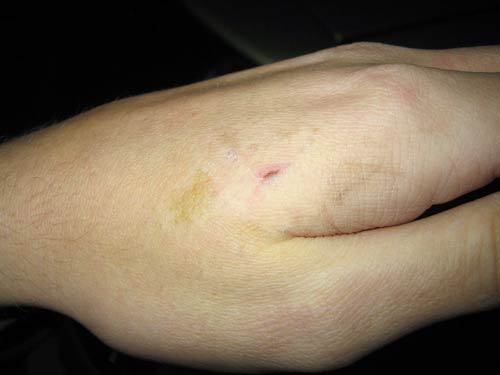

BME: |
Are you happy with the results so far?
|

AG: |
I am. The biggest challenge will be to come up with a computer system stable and reliable enough to let me in the door; that will be the real test. Ultimately, I will have to get an encrypted tag and find a sensor that can read the tag and interface well with a PC as well as a microcontroller, such as a BASIC STAMP or PIC processor. Chances are, the only reliable hardware I’ll be able to come up with is a dedicated microcontroller that can be programmed with “allowed” tags via a PC... but the actual work of letting people in the door will be done by microcontroller. That removes the stability, and power consumption of the PC, from the equation.
|

BME: |
Ideally, what sort of accessibility do you hope to see
this implant give you in the future?
|

AG: |
Well, because I’m writing my own software and soldering up my own stuff, pretty much anything I want. Well, more accurately, anything I have the time and inspiration to do. Ultimately though, I think true keyless access will require an implantable chip with a very strong encryption system; right now I’m only looking at this type of thing in a personal context.
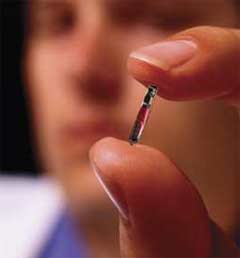
Verichip Corporation’s
implantable RFID tag
NOTE: Amal does not have a Verichip!
|
As for society at large, nightclubs in Spain are already using RFID chips to let customers put drinks on their tabs and enter VIP lounge areas, and I think Australian pubs are doing the same as well. I’m not sure if they use encrypted implants or not. I was more interested in just getting something simple, cheap, and fun to play with.
The chip itself is only $1.50, and I was able to get a 125KHz sensor/reader
for $50, so the total project cost so far is about $60 with shipping
and everything. An electronic strike for the front door will probably
run anywhere from $50 to $80 I’d imagine, and the time and cables
to get it all hooked up to a computer. The biggest issue for keyless
entry, besides security concerns, is the computer. I need to keep
a working, stable, reliable computer running at all times to monitor
the sensor and activate the door strike to let me in. For the car
though, this is not practical. There are other alternatives including
microcontrollers that would work, but the main thing is that you need
power for this system to work. So really, keyless entry is only a
luxury... I’d still have to carry keys around in my pocket — I just
hope the number of keys could be reduced. A car key would not be required,
as you would not be going anywhere fast with a dead car battery anyways,
but a house key might be nice if the power was out and you couldn’t
get in.
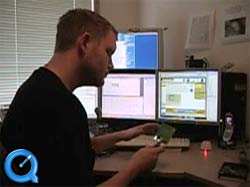
(QUICKTIME VIDEO, 573KB)
Initial testing of the RFID implant
|
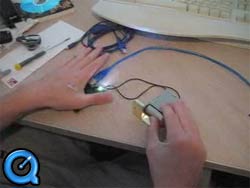
(QUICKTIME VIDEO, 369KB)
The RFID operated latch in action
|
|
Amal’s approach to impending technology is likely one of the best there is:
Get to know it personally, learn how to use it properly, and don’t let it
take advantage of you. If his experiment works as planned, he’ll have taken
a bold step in a direction that many of us have purposefully avoided and made
it work for him. Or, in his own words: “It’s one small step for hand, one
giant leap for keyless entry.”
You can stay updated as to Amal’s progress at http://amal.net/rfid.html
- Jordan Ginsberg (iam:snackninja)
IAM members click here to discuss or comment on this article
Follow-up letter:
|
Hey Jordan,
I just ran across your RFID article with Amal. I couldn't believe what I was reading, especially since I sold him the RFID chip and reader! I remember him asking about the biobond stuff and now I know why. I had no idea someone was going to be crazy techie enough to put one in their own hand. Wild.
Anyhow, I was surprised to see a whole article about someone using an RFID reader and chip from us with no mention or link.
I have no idea what policies the site has about such things, but I'm a small business doing everything I can to grow and I think this article will generate some publicity and would love to let people know where the RFID reader + chip came from.
Phidget RFID Reader and Tags
Small Glass Ampoule Tag
RFID reader
Matt Trossen
www.PhidgetsUSA.com
[email protected]
877-898-1005
|
|
|

A recent acquisition from the illustrious, high-profile world of low-budget
sporting-goods photography, Jordan Ginsberg is a Toronto native. Born
affiliated to the Levi tribe, Jordan renounced his religion shortly before
his Bar Mitzvah but still believes he is entitled to a role in the liberal
Jew-run media and sees BME as an ideal stepping stone. Votes left, throws
right.
Article copyright © 2005 BMEZINE.COM. First published March 30th, 2005 in La Paz, BCS, Mexico. Requests to reprint must be confirmed in writing.
|



